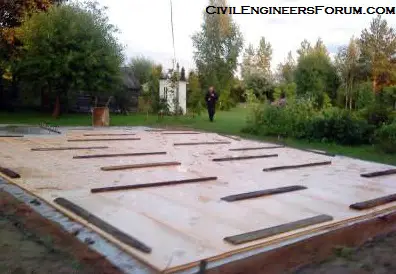What is a floating slab?
These slabs are constructed in two stages. In the first stage the footings are poured separately. The center floor of the floating slab is poured only after the footings have been cured. The slab is not anchored to the floor. This type of slab is typically used for shallow foundations like garages, sheds and light home extensions.

Floating slab construction
A building construction typically needs a solid foundation in which it can bear the weight of the entire structure, including the roof, floor and other loads it may contain. However, small structures such as sheds, garages, backyard extensions do not need elaborate and extra strong foundations as they are generally light in structure. Floating slab is an ideal solution for such basic foundation structures. This type of slab foundation is mostly used in northern climates as the slab does not require concrete footing with deep extensions below frost line. Floating slab is sometimes known as a raft foundation and they are generally constructed on soil with high proportions of sand, water or clay. A floating slab spreads the structure weight over the entire base instead of at strategic supporting columns. As they are shallow in depth they can ideally be used in specific construction locations.
Advantages of floating slabs
A floating slab is recommended for areas with lower load bearing capacities. Therefore, it can be used when required to erect a structure over loose soil or when there is varying degrees of compression in the soil. Floating foundations are capable of spreading weight support over a large area.
This type of slab is best used when a new foundation should not interfere with other building structures. Since a floating slab is placed just above earth instead of in it, the foundation forms a natural moisture barrier between the structure and ground. This makes it a preferred option for structures made on high moisture soils and colder climates.
As the slab does not require deep footer trenches, the floating slab can be poured with fewer exertions like digging and trenching. The slab will not disturb the natural earth lying beneath the building or interfere with its long established quality. Floating slabs are not compromised in areas with high vibration such as highways or mining areas where the earth is expected to shift as a result of high underground moisture.
Disadvantages of floating slabs
Some limitations associated with floating slab are its comparatively primitive technology, entrapped air within sealed floating foundation systems and lower design resonance. Floating slab foundations also have the distinct disadvantage of lack of underground access for utility lines.

